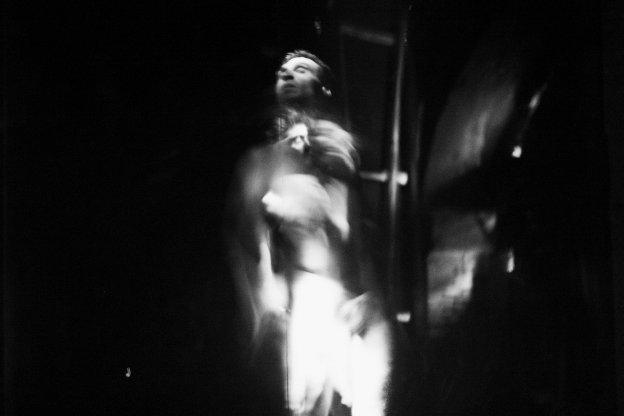Inspired by an aria from Purcell’s Baroque opera Dido and Aeneas (‘Remember me, but ah, forget my fate.’), Sineglossa’s short filmic theatre show (just 20 minutes in duration) is less a story than a visual and aural poem exploring how the desire to love absolutely can become a form of narcissism, the one who desires and the one who is desired merging into one entity… Or perhaps it can be read as a lament – the dead lover living on in the body of the one who remains behind.
Scenography is everything in this piece – all done with lights and mirrors, you could say. We are sat in tiered seats facing a sheet of glass, so all we can see is our own reflection – a group of people staring ahead in expectation. We are then plunged into total blackout. (The performance space is Summerhall’s specially-adapted Black Shed venue, used only for the two Grotowski-inspired shows here, this and Teatr Zar’s Total Theatre Award winning Caesarean Section: Essays on Suicide, both of which require complete blackout.)
From the darkness we see glimmers of light and we make out a figure looking at us from behind the glass, as recorded applause plays. It’s a female figure, dressed in a smart cocktail dress, high heels and a hat. She raises her hand and steps towards us as the applause crescendos, then there is a moment of blackout and we next see her to the rear of the space, hatless, confined by what seems to be a triangular formation of glass walls. The figure becomes more elusive, almost ghostlike. An electronic soundtrack starts up, small bleeps sounding almost like digital cicada, then a male voice begins to hum. The woman stands by a table lamp that is giving off a bright but blurred light, a beacon in the darkness that seems to be shining right through her body. She bends over and removes her shoes and possibly her underwear. The man is seemingly behind her. She wrings her hands, agitated, then almost signs the sounds heard (‘Re-mem-ber me…’) in a kind of eurythmic hand-dance. She turns and stares into what might be a mirror, and through the glass darkly a male figure appears. The lights are very low and it is hard to distinguish what happens next, but what appears to happen is that both figures, naked, merge together then vacillate between the two states, male and female, momentarily separating out in the blink of the eye, then merging again, the pace of the ‘frames’ increasing to a frenzy.
The figures fade away before our eyes and we are left once again facing a sheet of glass, watching ourselves applaud. We can imagine this as a circular piece, with the female figure in the cocktail dress once again emerging from the applause – but this doesn’t happen, other than in our imaginations.
Afterwards, it is hard to recall just what we have actually seen and what we have imagined – the piece plays cleverly with that tug between memory and imagination, and is of course also playing very knowingly with our perceptions, challenging us to differentiate between the real and the illusory. The ‘morphing’ effect is obviously a version of the classic stage magic illusion called Pepper’s Ghost, used here to great effect.
I go back the next day to see the show again, hoping for a little more insight – I’m just as entranced, but none the wiser. Sometimes that’s how it has to be.


